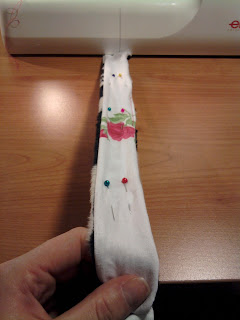Ostatnio w którymś z programów telewizyjnych usłyszałam, że spanie w opasce przyczynia się do polepszenia jakości snu. Z uwagi na to, że był to jeden z programów dla kobiet (w jakość żródeł informacji w nich zawartych powątpiewam dość często), puściłam to mimo uszu. Później, sięgając do mojej biologicznej wiedzy stwierdziłam, że może to być prawdą. Otóż wydzielamy pewien hormon: melatoninę, która odpowiada za regulację snu i czuwania. Wydziela się wtedy gdy jest ciemno i śpimy. Gdy zaczyna się robić jasno, melatoniny wydziela się coraz mniej i łatwiej się wybudzamy. Wydaje się, że jak jest noc, to musi być ciemno... nigdy jednak nie jest całkowicie ciemno. Zawsze dociera światło z latarni ulicznej, akurat jest pełnia, współlokator zapomniał zgasić światło w korytarzu itp. Opaska do spania wydaje się być rozwiązaniem.
I heard in one of the TV programmes lately that sleeping in a sleeping blindfold can improve the quality of our sleep. Due to the fact that it was one of the TV programmes for women (which the information source quality I doubt quite often), I just let it go. Later on, exploring my biological knowledge I thought it actually might have been true. We produce a hormone: melatonin, which is in charge of sleep and standby regulating. It is produced when it's dark and we sleep. The more light is around us, the less ammount of the hormone is produced and we gradually wake up. It seems that when the night comes, it's dark untill dawn... but it's never totally dark. There's always a little light from streetlight, the full moon, a flatmate left a light on in the hall etc. That's why a sleeping blindfold might be a good solution.
Po tej krótkiej lekcji biologii, bierzemy się do dzieła. So let's sew!!
After a short biology lesson, let's take an action. So let's sew!!
Potrzebne będą:
We are going to need:
1. Dwa rodzaje materiału, jeden z nich miękki i miły w dotyku
1. Two types of fabric, one of them should be soft
2. pasująca (bądź nie) nitka
2. matching thread
3. gumka
3. an elastic
4. Wykrój na opaskę Wykrój opaski / Blindfold Pattern
4. Blindfold Pattern
Z wykroju kroimy maskę z obydwu materiałów oraz pasek. Pasek należy dobrać do wymiaru głowy. Najlepiej odmierzyć centymetrem krawieckim odległość od skroni, przez tył głowy, do drugiej skroni i dodać 10cm. Szerokość paska to 6cm. Przygotowujemy również gumkę. Najlepiej przyłożyć ją do głowy tak jak przy wyznaczaniu długości paska. Naciągnij gumkę do takiego stopnia, żeby Cię nie uciskała. Utnij dwa takie same kawałki gumki.
Cut the mask out of the pattern from two fabrics and a stripe. The stripe should be fitted to your head. It's best to measure with a tape-measurethe length between your temples and add 10cm. The stripe should be 6cm wide. We should prepare an elastic. It's best to put it to your head just like you did to measure your stripe. Stretch the elastic from your temple to the other temple untill it's still comfortable to you and not to tight. Cut two the same length pieces of the elastic.
Składamy paski z dwóch materiałów twarzami do siebie, z jednej strony przypinamy gumki, tak jak na obrazku poniżej.
Face two stripes, pin the elastic as in the picture below.
Zszywamy jedną krótką krawędź (tę z gumkami) i jedną długą 0,5cm od krawędzi. Następnie przypinamy drugie końce gumek do drugiego końca paska i zszywamySew one short and one long edge 0,5cm from it. Next pin the other ends of elastics
Do zszycie została ostatnia długa krawędź. Zszywamy ją zostawiając na środku otwór szerokości ok 4cm. Przycinamy całość (oprócz materiału przy otworze) wzdłuż i blisko szwu, uważając, żeby go nie przeciąć.
There is one long egde to sew left. Sew it leaving in the middle about 4 cm slot. Trim the whole thing (apart from fabric at the slot) along the seam. Be careful not to cut through the seam.
Odwracamy całość na prawą stronę, zaginamy materiał przy otworze do środka i zwszywamy przy krawędzi
Turn the whole thing right side out, bend the fabric at the slot and sew near the edge.
Teraz zajmiemy się maską. Składamy dwa kawałki materiału twarzami do siebie i zszywamy wokół krawędzi zostawiając 3cm otwory po bokach.
Now it's time for the mask. Line two cut before pieces of fabric facing each other and sew along the edge leaving 3cm slots on both sides.
Teraz najtrudniejsza część. Trzeba zszyć ze sobą wszystkie trzy warstwy [paska (2 materiału i gumkę) ze sobą. Trudność polega na tym, że gumka (jak to gumka) ściąga materiał, no i nie widać jej, więc nie wiadomo gdzie szyć;) Dlatego trzeba sobie pomóc dużą ilością szpilek. Ja to zrobiłam w ten sposób jak na zdjęciu. Trzeba wyczuć gumki pod palcami i przypiąć dość gęsto.
Now, it's the most difficult part. We have to sew all 3 layers of the stripe (2 layers of fabric and 1 layer of elastic). The difficulty is with an elastic, because it (as any elastic) gathers the fabric, you can't see it and you don't know wher to sew;) That's why you need to ease yourself with a lot of pins. I did it in a way shown in the picture below. You need to feel the elastic under you fingers and pin quite dense.
A potem zszyć.
And sew.
Maskę wywracamy na prawą stronę. Wkładamy końcówki paska do otworów w masce zaginając wystający materiał do środka i zszywamy przy krawędzi.
Turn the mask right side out. Put the endings of the stripe in the slots of the mask, bending the sticking out fabric in and sew near the edge.
I GOTOWE:)
And DONE:)















